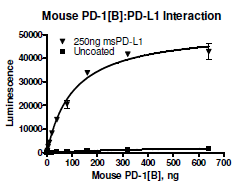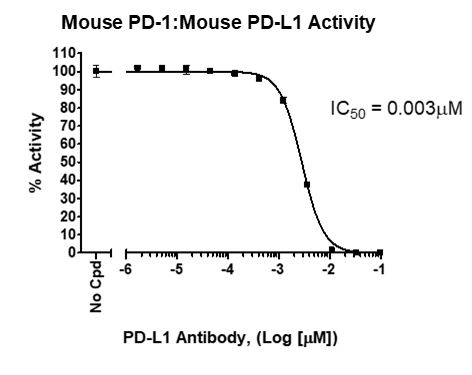Mouse PD-1[Biotinylated]:PD-L1 Inhibitor Screening Assay Kit
The Mouse PD-1[Biotinylated]:PD-L1 Inhibitor Screening Assay Kit is designed for screening and profiling inhibitors of this signaling. The key to this kit is the high sensitivity of detection of biotin-labeled PD-1 by streptavidin-HRP. Only a few simple steps on a microtiter plate are required for the assay. First, mouse PD-L1 is coated on a 96-well plate. Next, mouse PD-1 is incubated with mouse PD-L1 on the plate. Finally, the plate is treated with streptavidin-HRP followed by addition of an HRP substrate to produce chemiluminescence, which can then be measured using a chemiluminescence reader.
Need us to run inhibitor screens or profile your compounds against Mouse PD-1[Biotinylated]:PD-L1? Check out our Immunotherapy Biochemical Screening Services.
| Catalog # | Component | Amount | Storage | |
| 71117 | Mouse PD-L1, Fc fusion* | 30 µg | -80°C | Avoid freeze/ thaw cycles |
| 71118 | Mouse PD-1, Fc fusion, Biotin-labeled* | 10 µg | -80°C | |
| 79742 | Streptavidin-HRP | 10 µl | +4°C | |
| 3x Mouse PD-1 Assay Buffer | 50 ml | -20°C | ||
| 79728 | Blocking Buffer 2 | 50 ml | +4°C | |
| 79670 | ELISA ECL substrate A (transparent bottle) |
6 ml |
Room Temp. |
|
| ELISA ECL substrate B (brown bottle) |
6 ml |
Room Temp. |
||
| 79699 | White 96-well microplate | 1 | +4°C | |
*The concentrations of Mouse PD-L1 and Mouse PD-1 are lot-specific and will be indicated on the tubes containing the protein.
1. Lin, D., et al. Proc. Natl. Acad. Sci. USA. 2008, 105: 3011-3016.
2. Keir, M.E., et al. Annu. Rev. Immunol. 2008, 26: 677-704.



